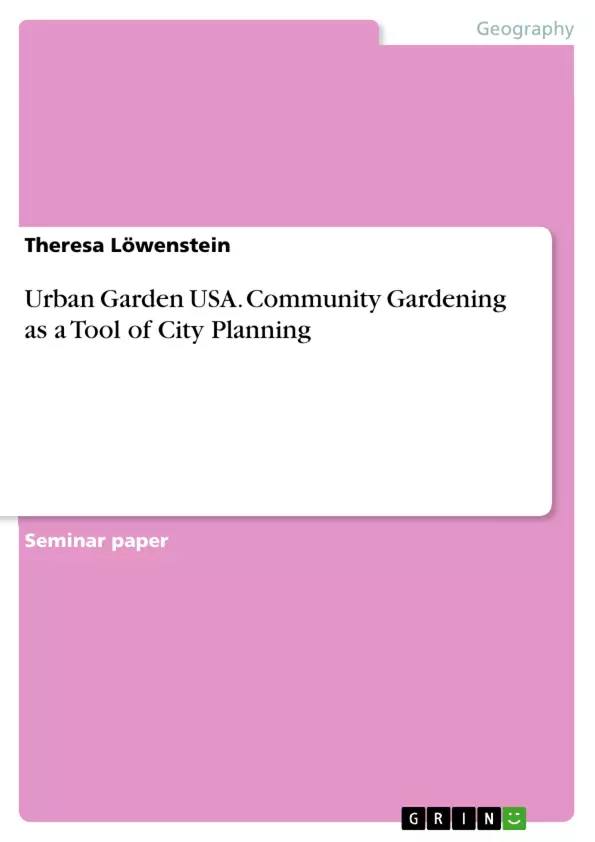In modern times society in most U.S. cities changed to “bedroom communities” where people stay home, watch television and forget how to live in the cultural, urban or even village sense. At the same time, however, issues such as global warming and sustainability gained attention, which led to the re-emergence of a movement within the city: Community Gardening.
The question to be answered is if Community Gardens/Urban Gardens (CG) are planned as a means to other objectives or an end in itself. If it is a means to other ends, the CG is only beneficial until the other aim is achieved. If not, the gardens serve a greater use than only to overcome crisis. This in turn would be an indicator that CG should be more recognized as a city-planning tool instead of decrease in times of peace and wealth.
In order to find out what role CG play in today’s urban planning and how it can contribute to improve urban conditions, I first have to illuminate the current problems in today’s cities. After having a general overview on the present urban conditions I than focus on the historical and current development of CG in general and in particular in the United States (U.S.).
Later I take a closer look on the general objectives behind the emergence of urban garden movements and the benefits that they contained in the past and present. Looking at recent prime examples of urban gardens in Berlin and San Diego will shed light on the goals behind and particular the benefits CG have on today’s urban environments, communities and its residents.
In the end I’ll give some recommendations on how CG should be implemented in the field of city planning to improve the described urban conditions.
Inhaltsverzeichnis (Table of Contents)
- 1. The Origin of Urban Gardens
- A. Challenges of Today's Urban Environments
- B. Characteristics of Community Gardens
- I. The History of Community Gardens
- II. Reasons for the Establishment of Community Gardens
- III. Benefits from Community Gardens
- 2. Possible Urban Spaces to integrate Community Gardens
- A. International Case Study: "Prinzessinengärten" in Berlin, Germany
- B. Local Case Study: Smart Farm San Diego
- 3. Role of Urban Gardens in the Field of City Planning
- A. Roots of Urban Planning
- B. Planning in Relation to the Idea of Urban Gardening
- C. How to implement Urban Gardens in the Field of City Planning
- I. Creating "Agriculture Incentive Zones" within Cities
- II. Vacant lot Asset Mapping
- III. Vacant Lot Cadaster
- IV. Integrate Urban Gardening as an Official Instrument of City Planning
Zielsetzung und Themenschwerpunkte (Objectives and Key Themes)
This research paper aims to investigate the role of community gardening as a tool of city planning. It examines the historical origins of urban gardens, the challenges of today's urban environments, and the benefits of community gardens. Additionally, the paper explores potential urban spaces for integrating community gardens, drawing on case studies from both Germany and the United States. Finally, the paper delves into how to implement urban gardening as a recognized component of city planning, suggesting strategies such as creating "Agriculture Incentive Zones" and utilizing vacant lot asset mapping.
- Community Gardening in Urban Environments
- Benefits of Community Gardens
- Urban Spaces for Integrating Community Gardens
- Role of Community Gardening in City Planning
- Implementation Strategies for Urban Gardening
Zusammenfassung der Kapitel (Chapter Summaries)
Chapter 1 provides a comprehensive overview of the historical context of urban gardens, highlighting the challenges posed by modern urban environments and exploring the characteristics, benefits, and motivations behind the establishment of community gardens.
Chapter 2 presents two case studies from different geographic locations – "Prinzessinengärten" in Berlin, Germany, and Smart Farm San Diego – showcasing successful examples of integrating community gardens within urban spaces.
Chapter 3 delves into the role of urban gardens in the field of city planning, examining the historical roots of urban planning, exploring the relationship between urban gardening and planning principles, and outlining strategies for incorporating urban gardens into official city planning practices, including the creation of "Agriculture Incentive Zones," vacant lot asset mapping, and establishing a vacant lot cadaster.
Schlüsselwörter (Keywords)
The paper focuses on the key themes of community gardening, urban planning, sustainable urban development, urban agriculture, and environmental stewardship. It highlights the importance of integrating community gardening practices as a tool for creating more resilient and equitable cities.
- Arbeit zitieren
- Theresa Löwenstein (Autor:in), 2014, Urban Garden USA. Community Gardening as a Tool of City Planning, München, GRIN Verlag, https://www.grin.com/document/299817



